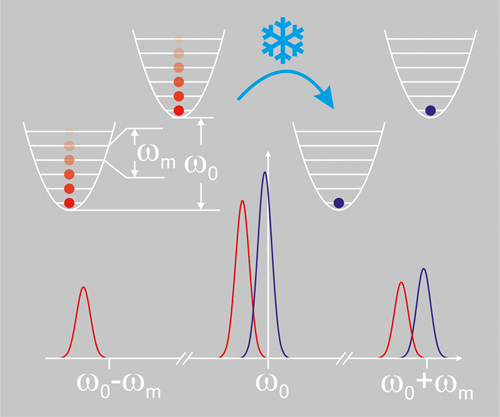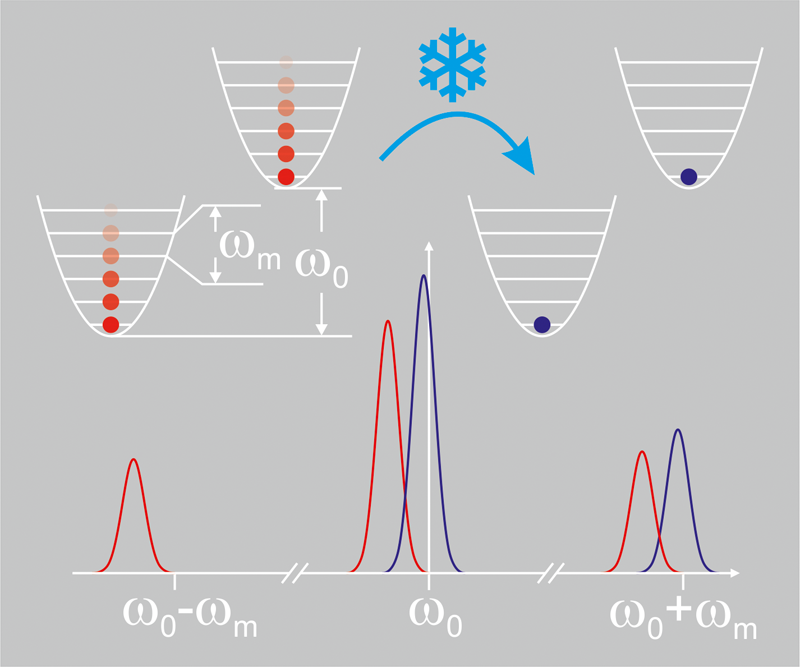Trapped Ions Stopped Cold
Today’s most advanced atomic clocks keep time thanks to an optical reference transition of either a trapped single ion or an ensemble of neutral atoms in an optical lattice. With an exceptional precision of a few parts in 10−18, one of the most important remaining sources of uncertainty for ion-based clocks is the thermal motion of the ion. Although the ions move at only a minute fraction of the speed of light, this motion, through the relativistic effect of time dilation, induces a shift on the frequency of the transition that is significant at these precision levels. Jwo-Sy Chen at the National Institute for Standards and Technology (NIST) in Boulder, Colorado, and co-workers have developed a new cooling approach that reduces the uncertainty associated with thermal motion by a factor of 50 compared to previous clocks based on the same ion ( 27Al+) [1]. The new method, which adds an extra step to current cooling techniques, might soon lead to record-breaking accuracies in ion-clock precision.
In an ion-based atomic clock, an ultrastable laser reads out the frequency of the reference transition of the trapped ion. Specifically, the transition is interrogated by measuring the probability of exciting it as a function of the laser frequency, and the process is repeated over many cycles. Accurate frequency readings require that the amplitude of the ion’s motion be significantly smaller than the wavelength of the probing laser. This in turn requires very low ion temperatures, which researchers typically accomplish using a laser-based method called Doppler cooling, a technique that brings the ion temperature into the low millikelvin range. For most ion clocks, Doppler cooling is sufficient to reach the so-called Lamb-Dicke regime, in which motional sidebands are well resolved with respect to the reference transition. Such sidebands arise because of the quantized motion of the ion in the trap (Fig. 1), and they are separated from the main transition by frequencies corresponding to quanta of vibrational motion. In the Lamb-Dicke regime, the narrow reference transition can be distinguished from the smaller motional sidebands and can thus be coherently interrogated, unaffected by the sidebands [2].
Doppler cooling has allowed 10−18 accuracy levels for 27Al+ clocks. However, to push the accuracy of these clocks further, researchers have to tackle the motion-induced frequency shift that arises from time dilation. Two types of residual motion during the interrogation of the reference transition are important.
The first is the ion’s “micromotion”—a motion that arises when the ion’s position shifts with respect to the minimum of the trapping potential. Ions are typically confined using radio frequency (rf) traps. In an ideal rf trap, the ion is located at the minimum of a harmonic potential. However, several effects, connected to imperfections of the trap’s rf field or to external static electric fields, may shift the ion’s placement, causing it to oscillate at the drive frequency of the trap. Various methods of minimizing and correcting for the micromotion with high precision are available, enabling relative frequency shift uncertainties below 10−19 [3, 4].
But the second cause of relativistic time dilation is harder to tackle. This comes from the residual quantized oscillations of the ion in its harmonic-potential trap. Due to thermal excitation, several quanta of vibration at the normal modes of the trap may be excited. This motion is often referred to as “secular motion.” The magnitude of this secular motion is determined by the ion’s temperature after laser cooling and the heat the ion absorbs during the interrogation by the clock’s laser. The resulting frequency shift is a key factor limiting the total uncertainty for many ion clocks [5–7]. In principle, by characterizing such motion, its effect on the reference transition can be corrected. But measuring it with sufficient accuracy is experimentally difficult. A much better approach is to decrease this kind of motion to a very low level.
That’s precisely what the NIST group accomplished, and they did so by finding a way to equip ion clocks with so-called resolved-sideband techniques that can break the Doppler cooling limit. Researchers demonstrated these cooling techniques 30 years ago, using them to cool a single ion to near its zero-point energy of motion [8]. Nowadays, such cooling techniques are routinely used in various trapped ion experiments for quantum simulation and quantum information processing. Their implementation in ion-based clocks, however, has been unhelpful so far because of the strong heating of the ion during the interrogation time and the difficulty of characterizing the resulting motional state distribution. Now, the NIST group has successfully extended the advantages of resolved sideband cooling techniques to ion clocks.
The authors demonstrated their new cooling approach on a 27Al+ ion clock. This clock is based on the transition between the 1S0 and 3P0 states of the 27Al+ ion. In fact, this ion lacks an adequate transition for Doppler cooling. Instead, accurate clocks have been enabled by a special trick known as quantum logic spectroscopy [9]. In such schemes, the motion of the 27Al+ ion is coupled to a simultaneously trapped “logic ion,” such as 25Mg+, through the Coulomb interaction. Doppler cooling of the 25Mg+ ion then sympathetically cools the 27Al+ ion. In addition, the coherent motion of the two coupled ions means that the logic ion can be used to read out the internal quantum state of the 27Al+ion.
Within the last few years, ion traps for various ion species have been developed that reduce the trap-induced frequency shifts and feature smaller heating rates [4, 7, 10]. Using such measures, Chen et al. have reduced the motional heating rate in their new ion trap by 2 orders of magnitude compared to those achieved in earlier 27Al+ ion clocks. With such a low heating rate, the uncertainty in the reference frequency can be significantly reduced by cooling the coupled ions to their respective three-dimensional motional ground states (Fig. 1) and by analyzing the motional heating process during the interrogation. Chen et al. compared data on the residual motion of the crystal with a rate-equation simulation and optimized the cooling sequence. Finally, they estimated an upper limit for the residual motion and validated their findings by comparing simulated and experimentally observed excitation probabilities on the motional sidebands and the main resonant frequency. In this way, they reduced the fractional uncertainty of the clock due to secular motion to 10−19.
It is worth noting that the authors reach this level of uncertainty for a tough test case: the 27Al+ ion is relatively light—its residual motion is larger than the heavier ions used in other ion clocks, like 171Yb+—and the Mg+– Al+ two-ion system is complex. This bodes well for applying similar techniques to all other ion-based clocks. With the relativistic time-dilation shift of the ion inside the clock now controlled at the quantum limit, the whole 27Al+ device could become a highly sensitive sensor for other relativistic effects, such as relativistic changes induced by gravity. With clock uncertainties of 10−19, the difference in Earth’s gravitational potential over a height of only about 1 millimeter would become measurable between two clocks. This ability would allow geodetic measurements whose precision would surpass that of all presently available techniques. We can also expect largely improved tests of fundamental principles such as searches for violations of Einstein’s equivalence principle and other key assumptions of the standard model of particle physics.
This research is published in Physical Review Letters.
References
- J.-S. Chen, S. M. Brewer, C. W. Chou, D. J. Wineland, D. R. Leibrandt, and D. B. Hume, “Sympathetic Ground State Cooling and Time-Dilation Shifts in an 27Al+ Optical Clock,” Phys. Rev. Lett. 118, 053002 (2017).
- A. D. Ludlow, M. M. Boyd, J. Ye, E. Peik, and P. O. Schmidt, “Optical Atomic Clocks,” Rev. Mod. Phys. 87, 637 (2015).
- D. J. Berkeland, J. D. Miller, J. C. Bergquist, W. M. Itano, and D. J. Wineland, “Minimization of Ion Micromotion in a Paul Trap,” J. Appl. Phys. 83, 5025 (1998).
- J. Keller, T. Burgermeister, D. Kalincev, J. Kiethe, and T. E. Mehlstäubler, “Evaluation of Trap-induced Systematic Frequency Shifts for a Multi-Ion Optical Clock at the 1019 Level,” J. Phys.: Conf. Ser. 723, 012027 (2016).
- C. W. Chou, D. B. Hume, J. C. J. Koelemeij, D. J. Wineland, and T. Rosenband, “Frequency Comparison of Two High-Accuracy Al+ Optical Clocks,” Phys. Rev. Lett. 104, 070802 (2010).
- N. Huntemann, C. Sanner, B. Lipphardt, C. Tamm, and E. Peik, “Single-Ion Atomic Clock with 3×1018 Systematic Uncertainty,” Phys. Rev. Lett. 116, 063001 (2016).
- P. B. R. Nisbet-Jones, S. A. King, J. M. Jones, R. M. Godun, C. F. A. Baynham, K. Bongs, M. Doležal, P. Balling, and P. Gill, “A Single-Ion Trap with Minimized Ion-Environment Interactions,” Appl. Phys. B 122, 57 (2016).
- F. Diedrich, J. C. Bergquist, W. M. Itano, and D. J. Wineland, “Laser Cooling to the Zero-Point Energy of Motion,” Phys. Rev. Lett. 62, 403 (1989).
- P. O. Schmidt, T. Rosenband, C. Langer, W. M. Itano, J. C. Bergquist, and D. J. Wineland, “Spectroscopy Using Quantum Logic,” Science 309, 749 (2005).
- P. Dubé, A. A. Madej, A. Shiner, and B. Jian, “88Sr+ Single-ion Optical Clock with a Stability Approaching the Quantum Projection Noise Limit,” Phys. Rev. A 92, 042119 (2015).





